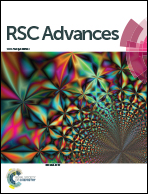Balanced strength and ductility improvement of in situ crosslinked polylactide/poly(ethylene terephthalate glycol) blends†
Abstract
Polylactide (PLA) is strong and stiff but brittle while poly(ethylene terephthalate glycol) (PETG) is flexible. In view of their complementary properties, PETG was blended with PLA via reactive melt blending to overcome the drawbacks of PLA, aiming at applications in the packaging industry. During reactive blending, crosslinking reaction between PLA chains and methylene diphenyl diisocyanate (MDI) led to improved melt elasticity, viscosity and molecular mass evaluated by various rheological plots including storage and loss modulus, viscosity, loss tangent, weighted relaxation spectra, and molecular weight distribution curves. Interfacial compatibilization occurred between PLA and PETG through the reaction of free isocyanate groups on the crosslinked PLA chains with the terminal hydroxyl groups of the PETG chains. The variation of viscoelasticity of the PLA matrix and interfacial compatibilization resulted in fine phase morphology and enhanced interfacial adhesion of the blends. Thus, the failure mode of the blends changed from brittle fracture of neat PLA to ductile fracture. The resulting PLA-MDI/PETG blends displayed a significant improvement in the elongation at break and a simultaneous improvement of tensile strength, maintaining the high tensile modulus.


 Please wait while we load your content...
Please wait while we load your content...